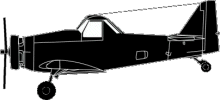
ASN Wikibase Occurrence # 198980
This information is added by users of ASN. Neither ASN nor the Flight Safety Foundation are responsible for the completeness or correctness of this information.
If you feel this information is incomplete or incorrect, you can submit corrected information.
| Date: | Monday 10 April 2017 |
| Time: | 17:00 |
| Type: |  Weatherly 620B |
| Owner/operator: | Skyline Aviation Llc |
| Registration: | N9004M |
| MSN: | 1604 |
| Year of manufacture: | 1995 |
| Total airframe hrs: | 2534 hours |
| Engine model: | P&W R-985/AN14B |
| Fatalities: | Fatalities: 0 / Occupants: 1 |
| Aircraft damage: | Substantial |
| Category: | Accident |
| Location: | LEWISTOWN, MT -
 United States of America United States of America
|
| Phase: | Manoeuvring (airshow, firefighting, ag.ops.) |
| Nature: | Agricultural |
| Departure airport: | Lewistown, MT (LWT) |
| Lewistown, MT (LWT) | |
| Investigating agency: | NTSB |
| Confidence Rating: |
The pilot reported that, during a low-altitude, practice agricultural application flight, he lost depth perception between the snow-covered ground and overcast sky. He added that the airplane impacted the ground and came to rest after sliding about 500 ft.
The airplane sustained substantial damage to the right wing and fuselage.
The pilot reported that there were no preaccident mechanical failures or malfunctions with the airplane that would have precluded normal operation.
The Federal Aviation Administration’s pamphlet, “Flying in Flat Light and White Out Conditions,” states the following:
Flat light is an optical illusion, also known as “sector or partial white out.” It is not as severe as “white out” but the condition causes pilots to lose their depth-of-field and contrast in vision. Flat light conditions are usually accompanied by overcast skies inhibiting any good visual clues. Such conditions can occur anywhere in the world, primarily in snow covered areas but can occur in dust, sand, mud flats, or on glassy water. Flat light can completely obscure features of the terrain, creating an inability to distinguish distances and closure rates. As a result of this reflected light, it can give pilots the illusion of ascending or descending when actually flying level. However, with good judgment and proper training and planning, it is possible to safely operate an aircraft in flat light conditions.
Probable Cause: The pilot’s failure to maintain altitude during low-altitude maneuvers in flat light conditions.
Accident investigation:
 |
|
Sources:
NTSB
Location
Revision history:
| Date/time | Contributor | Updates |
|---|---|---|
| 19-Aug-2017 16:16 | ASN Update Bot | Added |
Corrections or additions? ... Edit this accident description
The Aviation Safety Network is an exclusive service provided by:


 ©2024 Flight Safety Foundation
©2024 Flight Safety Foundation